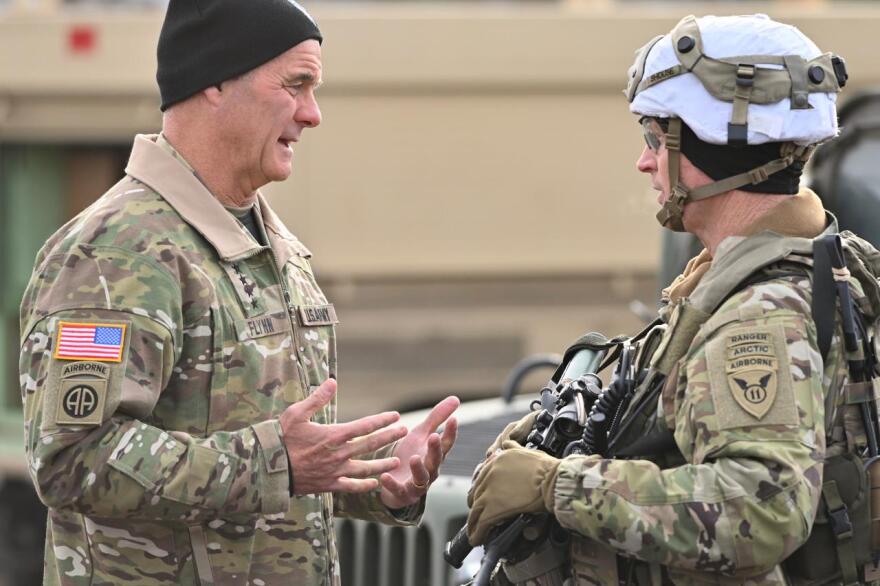‘Handful’ of Strykers remaining at Fort Wainwright now used for training for weapons of mass destruction
The Army has sent 90 Stryker vehicles from Fort Wainwright to Ukraine to help the nation defend itself. And as KUAC’s Tim Ellis reports, the fort still has a few Strykers around to help soldiers train to defend against attack with weapons of mass destruction.
The Army transferred 329 Strykers from Fort Wainwright to the Anniston Army Depot in Alabama last fall, then in January sent 90 of them to Ukraine as part of a military-aid package.

“Those are the ones that have been utilized to support the Ukrainian effort,” says Ashley John, a spokesperson for the Army’s Ground Combat Systems Program Executive Office in Michigan. John said in an email Monday that the Strykers sent overseas were “part of the U.S. commitment to provide security assistance to Ukraine.”
In February, the U.S. sent about 30 Strykers to Bulgaria, a Balkan nation south of Ukraine.
11th Airborne Division commander Maj. Gen. Brian Eifler says the Stryker transfer to Ukraine was done after the Army decided last fall that the vehicles wouldn’t fit with the division’s directive to focus on defending the Arctic and training here.
“That was a decision made at the Army level, to divest of the Strykers and work on a force that’s more capable in the region and also training in that environment,” Eifler said in a news conference last month. He said the iconic, multiwheeled, lightly armored vehicles were no longer suited for the division and its two newly reorganized brigades: a mainly infantry unit based at Fort Wainwright and an airborne unit at Joint Base Elemendorf Richardson.
But the Army decided to keep a few specially equipped Strykers in Alaska.
“Back in September, we divested ourselves of probably 99 percent of the Strykers that we had here at Wainwright. However, one unit did keep a small handful of them,” says Eve Baker, a Fort Wainwright spokesperson. She was referring to the 17th Combat Sustainment Support Battalion. The unit specializes in training soldiers on how to respond to attacks involving chemical, biological, radiological and nuclear weapons.

“So these Stryker vehicles have radiation-detection equipment and protective abilities, and they’re used Armywide in this type of unit,” she said in an interview last week
Baker says some of those Strykers and their crews took part in last month’s Joint Pacific Multinational Readiness Center, or JPMRC, training exercise held on training areas around Fort Wainwright.
“So people may see them and be confused,” she said, “but we did divest ourselves of the vast majority of the Stryker vehicles.”
Meanwhile, Army officials are trying to figure out what to do with the rest of the Strykers.
“The Army is still considering several options on what they intend to do with the particular Strykers that came out of Alaska,” says Gen.Charles Flynn, who heads up the Army’s Pacific Command. Both he and Eifler talked about Strykers and the JPMRC exercise during a March 30 news conference at Fort Wainwright.
“Obviously they need to be upgraded,” Flynn said, “but there’s a wide range of options that the Headquarters Department of the Army is working their way through.”
Army officials say the Stryker is a versatile platform that supports 18 variations that include vehicles equipped with armaments like mortars or cannons, and others that transport soldiers and supplies and clear minefields. Flynn said the Army is modernized some Strykers to accommodate short-range air-defense and intelligence-collection systems.



